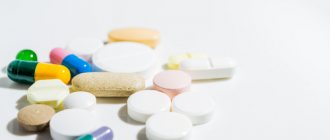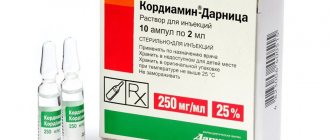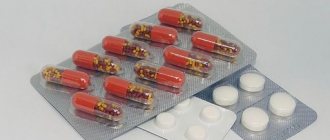Pharmacodynamics
In the large intestine, lactitol is broken down by intestinal flora into low-molecular organic acids, which leads to an increase in osmotic pressure in the large intestine, an increase in the volume of feces, their softening, easier bowel movements and normalization of intestinal function. The laxative effect usually occurs within 24 hours after using the drug (the delay is due to the passage of the drug through the gastrointestinal tract). At the beginning of the course of treatment, the laxative effect of the drug may be delayed; the effect may occur on the 2nd or 3rd day of its use.
In patients with hepatic encephalopathy or coma (or precoma), the effect is achieved due to the migration of ammonia from the blood into the large intestine (due to a decrease in pH, an increase in osmotic pressure in the intestinal lumen), removal of retained ammonium ions and other nitrogen-containing toxic substances from the colon. Lactitol inhibits proteolytic bacteria and increases the number of acidophilic bacteria.
Exportal pores for oral administration pak 5g N6
Registration Certificate Holder
VALENTA PHARM (Russia)
Dosage form
Medicinal product – Exportale®
Description
Powder for solution for oral administration
white, crystalline.
1 pack
lactitol monohydrate 5 g
5 g - single-dose sachets (2) - strips (3) - cardboard packs. 5 g - single-dose sachets (2) - strips (6) - cardboard packs.
Indications
Constipation, stool regulation (including with hemorrhoids, preparation for operations and after operations on the rectum, anal sphincter and the adjacent area).
Hepatic encephalopathy, hepatic coma and precoma, hyperammonemia.
Contraindications for use
Galactosemia, intestinal obstruction, suspicion of organic damage to the gastrointestinal tract, abdominal pain, rectal bleeding of unknown origin, previous water and electrolyte imbalance, children under 1 year of age, hypersensitivity to lactitol.
pharmachologic effect
Laxative and hippoammonemic agent.
In the large intestine, lactitol is broken down by the intestinal flora into low-molecular organic acids that increase osmotic pressure, which helps to increase the volume of feces, soften them, and facilitate the act of defecation. The laxative effect occurs within 24 hours after use or on the 2-3rd day (due to the passage of lactitol through the gastrointestinal tract).
In hepatic encephalopathy or hepatic coma (or precoma), the effect is achieved through the transport of ammonia from the blood to the large intestine (due to a decrease in pH, an increase in osmotic pressure in the intestinal lumen) and the removal of ammonium ions and other nitrogen-containing toxic substances from the colon.
It has a prebiotic effect, restores its own intestinal microbiome.
Suppresses proteolytic bacteria and increases the number of acidophilic bacteria.
Drug interactions
When taken concomitantly with enteric pH-dependent release drugs, it should be taken into account that lactitol reduces intestinal pH.
Dosage regimen
Taken orally.
The dose and frequency of administration depend on age and indications for use.
Side effect
From the digestive system:
flatulence, abdominal pain, vomiting, diarrhea; very rarely - nausea, anal itching.
From the side of metabolism:
with long-term use in high doses in the treatment of hepatic encephalopathy, electrolyte imbalance may occur.
special instructions
Use with caution in patients with a tendency to disturb water and electrolyte balance.
During treatment, increased fluid intake is desirable.
The interval between doses of other medications is at least 2 hours.
Use during pregnancy and breastfeeding
Restrictions during pregnancy - With caution. Restrictions when breastfeeding - With caution.
Can be used during pregnancy and lactation in cases where the expected benefit of therapy for the mother outweighs the possible risk for the fetus or infant.
Use for liver dysfunction
Restrictions for liver dysfunction - With caution.
For hepatic encephalopathy, hepatic precoma and coma, the dose is set individually.
Use in children
Restrictions for children - With caution.
Contraindicated for use in children under 1 year of age.
Directions for use and doses
Inside, during meals, mixing with various drinks (including water, tea, coffee, juices) or liquid food.
Constipation and dysbiosis. The drug should be taken once, the entire daily dose at once, in one go. Adults - 20 g/day (4 teaspoons of powder); children 12–16 years old - 10–20 g/day (2–4 teaspoons of powder); 6–12 years – 5–10 g/day (1–2 teaspoons of powder); 1–6 years – 2.5–5 g/day (0.5–1 teaspoon of powder).
The drug should induce stool once a day; After the onset of a stable laxative effect within several days of using the drug, its dose can be reduced. In some cases, half the recommended daily dose is sufficient to obtain the desired effect. The minimum course of therapy, after which you should consult a doctor, is 5 months. The use of the drug in children is recommended under medical supervision.
Regulating stool for medical purposes. 20 g of the drug, diluted in 1 liter of water, is taken 3 times (at 12, 15 and 18 hours) on the eve of medical procedures.
Hepatic encephalopathy, hepatic precoma and coma, hyperammonemia. The dose of the drug should be selected individually for each patient, depending on the severity of the disease and individual response to the drug. The initial daily dose is usually 0.5–0.7 g/kg. This dose is divided into 3 single doses. A dose should be selected that causes two soft stools per day.
Exportal® is more than just a laxative!
Exportal®
helps eliminate constipation and restore intestinal barrier function to protect the whole body from endotoxin aggression1,2.
The active ingredient, lactitol, belongs to the group of osmotic laxatives recommended by the Russian Gastroenterological Association and the Society of Children's Gastroenterologists, Nutritionists and Hepatologists as first-line drugs for the drug treatment of constipation1,2.
Lactitol attracts and retains water in the lumen of the colon. As a result, the contents of the colon soften to make bowel movements easier. 1.
Subsequently, lactitol is processed by bacteria that are beneficial to the human body and live in the large intestine, producing large amounts of butyric acid. Butyric acid “nourishes” the intestinal cells, which helps restore its barrier function to protect the body from the penetration of bacteria and their components (for example, endotoxins) from the intestinal lumen2,3.
In addition, lactitol “feeds” colon bacteria that are beneficial to the human body, thus restoring the microbiome (the prebiotic effect of lactitol, similar to the effect of dietary fiber)1.
Exportal®1
- Does not contain excipients, dyes or flavors;
- Tastes similar to table sugar but less sweet;
- Packaged in sachets, which are convenient to take with you;
- Acts only in the intestinal lumen;
Exportal® can be used1:
- children over 1 year old;
- pregnant and lactating women (if the potential benefit to the mother outweighs the potential risk to the fetus and child);
- patients with diabetes mellitus, because lactitol does not increase blood glucose levels;
- patients with liver diseases;
- To old people.
Directions for use: Exportal®1: 1 time per day, orally during meals, mixed with various drinks (water, tea, coffee, juices, etc.) or liquid food.
________________________________________________
1IMP Exportal LSR-003898/07
2Ardatskaya M.D. et al. Clinical and metabolic effectiveness of lactitol in the treatment of chronic constipation (results of the non-interventional prospective observational program “OSMOAID”) // Experimental and Clinical Gastroenterology. – 2021. – No. 2 (150).
3Ivashkin V. T. et al. Diagnosis and treatment of constipation in adults (Clinical recommendations of the Russian Gastroenterological Association and the Association of Coloproctologists of Russia) // Russian Journal of Gastroenterology, Hepatology, Coloproctology. – 2021. – T. 30. – No. 6. – pp. 69-85.
4Belmer S.V. et al. Functional disorders of the digestive organs in children. Recommendations of the Society of Pediatric Gastroenterologists, Hepatologists and Nutritionists. Part 2 // Russian Bulletin of Perinatology and Pediatrics. – 2021. – T. 65. – No. 5.
special instructions
Lactitol has a low calorie content (2 kcal/g), does not affect blood glucose levels and can be used in patients with diabetes.
Throughout the entire course of use of the drug, increased fluid intake is desirable.
Impact on the ability to drive vehicles and operate machinery. The use of the drug Exportal® does not affect psychomotor functions associated with driving a car or operating machines and mechanisms.
Exportal
Exportal ®
(lat.
exportale
) - medicine, osmotic laxative, prebiotic. Exportal is produced in the form of sachets containing 10 g of powder of the active substance - lactitol monohydrate for the preparation of a solution for oral administration.
Indications for use Exportal
- constipation
- regulation of stool in case of hemorrhoids, in preparation for operations and after operations on the rectum, anal sphincters, perineum and in other situations
- hepatic encephalopathy
- hepatic coma and precoma
- hyperammonemia.
Method of application of exportal and dose
Exportal is taken orally during meals, mixed with various drinks: water, tea, coffee, juices or liquid food. Exportal should be taken once, the entire daily dose at once, in one dose. Daily dose of Exportal for constipation:
- children 1–6 years old – 2.5–5 g
- children 6–12 years old – 5–10 g
- children 12–16 years old – 10–20 g
- adults - 20 years
Exportal should cause one bowel movement per day.
After the onset of a stable laxative effect within several days of using Exportal, its dose can be reduced. A laxative effect is often achieved by taking half the above dose. Daily dose of Exportal for hepatic encephalopathy, hepatic precoma and coma, hyperammonemia
should be selected individually for each patient, depending on the severity of the disease and individual response to Eexportal, based on the fact that the initial daily dose should be 0.5–0.7 g per 1 kg of body weight. Exportal is taken three times a day, with meals, one third of the daily dose with meals. The dose is gradually selected to cause two “soft” bowel movements per day.
Side effects of Exportal
At the beginning of therapy with Exportal, there may be a feeling of discomfort in the abdomen and flatulence, which, as a rule, disappear with continued use of Exportal.
Comparison of Exportal with other laxatives
Exportal, compared to Forlax, has higher clinical efficacy in the treatment of chronic constipation in elderly and senile patients, fewer side effects and a faster response to therapy.
This is due to the more pronounced effect of Exportal on the motor activity of the colon, confirmed by electrogastroenterography data, as well as the normalization of the disturbed intestinal ecosystem, which was expressed by more significant changes in the concentration and qualitative composition of short-chain fatty acids, which are metabolites of the obligate microflora of the colon (Minushkin O.N. and etc.). Exportal has advantages over other laxatives, allowing its use in a wide variety of patient groups (Kolkhir V.K.):
- Exportal has a mild laxative effect and a stable effect from the use of the drug. Clinical studies confirm that with prolonged use and repeated repeated treatment, Exportal is not addictive, and therefore no upward dose adjustment is required
- lactitol is not broken down and not absorbed in the small intestine. Exportal has a low calorie content and does not affect blood glucose levels, so Exportal, unlike lactulose-based drugs, can be used in patients with diabetes
- Export can be taken by pregnant women and children over 1 year of age
- Exportal does not have a destructive effect on tooth enamel, since, unlike other substances, it does not reduce the pH level in the oral cavity and does not cause caries, which is important for long-term use of laxatives
- Exportal does not affect the excretion of calcium in the urine and the metabolism of bone tissue in terms of the concentration of parathyroid hormone, osteocalcin and alkaline phosphatase. At the recommended dosage, it also does not affect the concentration of phosphate and calcium in the blood.
- Exportal sachets contain only the active ingredient - lactitol and no other additional substances. Export can be stored for a long time and is convenient to use. To dissolve the drug, the patient can choose the most suitable drink for him.
- the taste of lactitol, according to more than 70% of many patients, is superior to the taste of lactulose
- Exportal is effective for chronic constipation of various etiologies, functional constipation, as a means of accelerating the restoration of defecation function and facilitating defecation after operations on the anal sphincter, and also as a drug necessary for softening stool for medical purposes, including hemorrhoids, preparation for operations and after operations on the rectum.
Exportal also has prebiotic properties: it selectively stimulates the growth of sugar-splitting bacteria that have a beneficial effect on human health - bifidobacteria and lactobacilli, including lactobacilli acidophilus, inhibits the growth of enterobacters and enterococci, and inhibits the adhesion of E. coli to epithelial cells. Lactitol, unlike lactulose, is not broken down by E. coli and is broken down by significantly fewer strains of Staphylococcus aureus and Clostridium perfringens (Kolkhir V.K.).
Contraindications to the use of Exportal
Lactitol intolerance, galactosemia, intestinal obstruction, suspected organic damage to the gastrointestinal tract, abdominal pain and rectal bleeding of unknown origin.
Professional medical publications concerning the use of Exportal in the treatment of gastrointestinal diseases:
- Minushkin O.N., Ardatskaya M.D., Voskoboynikova I.V., Kolkhir V.K. Exportal (Lactitol) is an effective and safe osmotic laxative // RZHGGK. - 2010. - T.20. - No. 5. - Adj. No. 36. — P. 118.
- Minushkin O.N., Ardatskaya M.D., Voskoboynikova I.V., Kolkhir V.K. Analysis of the clinical effectiveness of the drugs Exportal and Forlax // RZHGGK. - 2010. - T.20. - No. 5. - Adj. No. 36. — P. 118.
- Minushkin O.N. Chronic constipation // Medical advice. 2015. No. 13. pp. 100-105.
- Gasilina T.V., Belmer S.V. Issues of drug therapy for constipation of functional origin in children // Medical Council. 2015. No. 14. pp. 54–58.
- Ardatskaya M.D., Butorova L.I., Grigorieva Yu.V. et al. Clinical and metabolic effectiveness of lactitol in the treatment of chronic constipation (results of the non-interventional prospective observational program “Osmoaid”). Experimental and Clinical Gastroenterology 2018;150(2):149–160.
On the website GastroScan.ru in the “Literature” section there is a subsection “Laxatives”, containing publications for healthcare professionals regarding laxatives and their use.
Additional Information
Exportal (lactitol) has a low calorie content (2 kcal/g), does not affect blood glucose levels and can be used in patients with diabetes.
Exportal is a prescription medicine. Throughout the entire course of therapy with Exportal, increased fluid intake is desirable.
Exportal does not affect psychomotor functions associated with driving a car or operating machines and mechanisms.
According to the pharmacological index, Exportal belongs to the group “Laxatives”. For ATC - to the group “Osmotic laxatives”, code A06AD12.
Other trade names of drugs with the active substance lactitol: Lactitol monohydrate.
“Instructions for medical use of the drug Exportal” (pdf), powder for the preparation of a solution for oral administration. Exportal developer company:
CJSC FPK "FarmVILAR", Russia. In March 2015, the right to produce Exportal was sold to Valenta Pharm OJSC. Back to section


